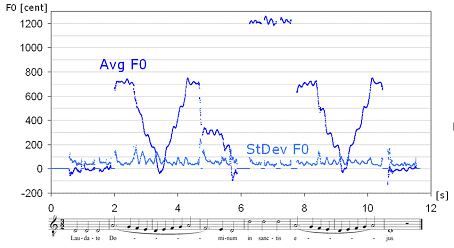What Are the Differences Between
Amateur and Professional Choirs?
Harald Jers (jers@speech.kth.se; harald.jers@gmx.de)
University of Cologne
KTH Stockholm, Department of Speech, Music and Hearing
Popular version of paper 4aMU1
Presented Thursday morning, November 20, 2005
150th ASA Meeting, Minneapolis
1. Introduction
What are the differences between professional and amateur choirs? To answer
this question let's first listen to a choir singing a short piece in a church:
Sound Example 1
This piece is a short canon from Praetorius, which was sung in unison in this
sound example.

Let's listen to the same piece sung by an amateur choir:
Sound Example 2
There are some small differences between these two sound examples! But what are the differences in detail? How do we find out? Is it a phenomenon related to collective singing of the entire group or just to the individual singers?
2. Chorus Effect
In a choir group, many people are singing the same piece at the same time.
In this case the normal mechanisms of the auditory localization of single voices
are disrupted, this is called the "chorus effect." This phenomenon
is even stronger in rooms with different acoustics. To get closer to this, let's
listen to these two choirs singing the same piece in a drier (less reverberant)
room, for example a recording studio of a radio broadcasting station!
Sound Example 3
Sound Example 4
Now some more differences are obvious. Because of less reflections from the
walls, the chorus effect decreases. We know this from our experience as singers
in choirs, that it is different to sing in different rooms and sometimes more
challenging to sing either in rooms with dry acoustics or in rooms with a lot
of reverberation.
3. Multitrack analysis
With a special technical setup it is possible to listen to these choirs, as
if there was no room around them. And, what is more, we can listen to a single-voice
section of sopranos, altos, tenors and basses and besides that also to the single
voices themselves.
Please listen first to the amateur choir, singing as if there was no room, then
to the tenor section of choir and to a single tenor singing within this group.
Sound Example 5
Sound Example 6
Sound Example 7
If we use this audio material for further analysis, we might find some hints
to the quality of the choirs and the differences between them:
Let's have a look at the behavior of the fundamental frequency (so-called F0)
of the choirs. If we calculate the mean value of all the singers in the choir
(which covered 16 singers per choir in this case), we see differences in their
singing behavior. The standard deviation gives a clue for their accuracy in
singing.

Professional choir: "Laudate Dominum" in unison, Avg F0 (dark green) and StDev F0 (light green)

Amateur choir: "Laudate Dominum" in unison, Avg
F0 (dark blue) and StDev F0 (light blue)
Both choirs have in common:
- the fifth and octave are pitched a lot higher than expected
- increasing standard deviation at the beginning of each changing tone; the
accuracy of pitch intonation and synchronization is low at the beginning of
tones and reaches a kind of minimum value for intonation
- the bigger an interval to be sung, the larger the failing of the singers
- most of the notes are reached with over- or undershoots
- notes in ascending scales are pitched higher and in descending scales pitched
flat
Differences between a professional and amateur choir
- tonal steps can clearly be seen in a professional choir, not so clearly in
an amateur choir, even though the ears identify them as steps
- repetition of notes seems to be more difficult for amateur choirs, not so
difficult for professional singers
- there seems to be a kind of vibrato synchronization for long notes in the
whole choir, a little bit more for an amateur choir
4. Conference Presentation and Future Work
At the ASA meeting conference many more analyses of the audio material are
shown in detail:
How the choir behaves, when a piece is sung more slowly, or as a polyphonic
canon having a closer look at the fundamental frequency, the timing/synchronization,
the loudness (sound pressure level, SPL) and the sound of the choir.
There is a huge amount of audio material which will be evaluated in the next
years, concerning different pieces, singing exercises, influence of sitting
or standing, vibrato behavior, influence of different vowels, acoustical interaction
between neighboring singers, maximum timing precision of choir singers, aural
training for conductors concerning these aspects, etc.